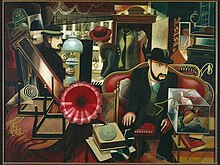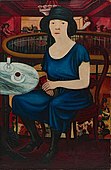|
Ernst Thoms  Ernst Thoms (November 13, 1896 – May 11, 1983) was a German painter associated with the New Objectivity. Thoms was born in Nienburg. He apprenticed as a painter from 1911 to 1914.[1] At the start of World War I in 1914, he entered military service. He was captured as a prisoner of war and held in England for five years ending in 1919.[2] In 1920, Thoms studied under Fritz Burger-Mühlfeld at the School of Arts and Crafts in Hanover.[2] He found work as a stage-set painter at the Opera House in Hanover during 1924–25. Like the other New Objectivity artists active in Hanover, Thoms worked in a style that was unsentimental but "often reveals moods of a lyrical and fairy-tale-like nature", according to Sergiusz Michalski.[3] In Attic (1926), Thoms presents prosaic subject matter in an undramatic way that nevertheless, with its openings into glimpsed spaces, suggests a mystery.[4] Among the Hanover New Objectivity artists, Thoms was the only one who received any support from the Kestner-Society, which gave him a solo exhibition in 1926.[5] He was also the only one who gained exposure in Berlin, where he had a solo show in 1928 in the Galerie Neumann-Nierendorf.[6] He joined the Hanover Secession in 1931. Thoms was in military service during 1939–40. In 1943, Allied bombing destroyed his house and studio, causing a loss of many of his works.[1] He was given a retrospective at the Hanover Kunstverein in 1957, and in 1964 was awarded the Grand Cross of Merit of the Lower-Saxony Order of Merit.[1] Thoms died in Wietzen in 1983.
NotesRead moreErnst Thoms at deutsch Wikipedia References
|
Portal di Ensiklopedia Dunia


